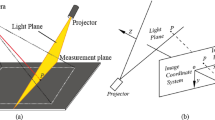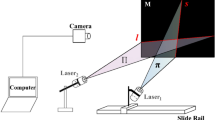Abstract
This paper presents a binocular stereo calibration algorithm using linear-structured light under high-precision industrial measurement situations. We propose a kind of light plane calibration method that improves accuracy using line-structured light and stereo vision. It has more matching points and higher location accuracy. Firstly, we extract the laser points from stereo image pairs accurately with the designed target after intrinsic parameters calibrated by the Tsai method. Secondly, we match the laser points and reconstruct them in 3d space to obtain the 3d laser point. Repeat the point obtain process in different positions until the 3d laser point set consists of enough points. Then, we construct an optimization problem with fuzzy membership grades expert weight. Finally, the light plane is calibrated by solving the optimization problem with the least square method. The algorithm’s availability is assessed by applying a self-referenced line-structured light scanning system with two cameras. Experimental results indicate that the RMS calibration error with the proposed algorithm is less than 0.033 mm, and the scanning error is 0.064 mm.
Access this article
We’re sorry, something doesn't seem to be working properly.
Please try refreshing the page. If that doesn't work, please contact support so we can address the problem.










Similar content being viewed by others
Explore related subjects
Discover the latest articles, news and stories from top researchers in related subjects.References
Jun, Lu., Xin, Z., Le, G.: Research on color structured light coding and decoding method based on the De Bruijn sequences. J. Optoelectron. Laser 25(1), 147–155 (2014)
Darimireddi, S.R., Prakash, T.S.: Spur gear progress using rapid prototyping by reverse engineering. Int. J. Res. 11(1), 1222–1229 (2014)
Junhua, S., Zhen, Y., Qianzhe, L., et al.: Synchronous and automatic registration method for 3-D measurement data. J. Optoelectron. Laser 20(6), 789–879 (2009)
Zurong, Q., Peifen, C., Xinghua, Li.: Calibration of measurement system for multi-vision sensor. Semicond. Optoelectron. 35(5), 889–893 (2014)
Ming, J., Zhiyang, Z., Min, Z., et al.: A virtual network mapping algorithm based on time. Chin. J. Electron. 23(1), 31–36 (2014)
Kaiyi, Z., Hongfang, C., Shulian, Z., Zhaoyao, S., Yun, W., Yidong, T.: Frequency-shifted optical feedback measurement technologies using a solid-state microchip laser. Appl. Sci. 9(1), 109 (2019)
Vilaca, J., Fonseca, J.C., Pinho, A.M.: Calibration procedure for 3D measurement systems using two cameras and laser line. Opt. Laser Technol. 41(2), 112–119 (2009)
Feng, X., Xu, H., Li, W., et al.: Centroid position algorithm of structure optical stripe in asphalt pavement test. J Optoelectron. Laser 25(3), 514–520 (2014)
Zhao, Y., Chen, X.: The circular points-based camera self-calibration study on three classification algorithms. J. Comput. Inf. Syst. 7(4), 1140–1147 (2011)
Li, B., Karpinsky, N., Zhang, S.: Novel calibration method for structured-light system with an out-of-focus projector. Appl. Opt. 53(16), 3415–3426 (2014)
Qiang, Fu., Quan, Q., Kaiyuan, C.: Calibration method and experiments of multi-camera’s parameters based on freely moving one-dimensional calibration object. Control Theory Appl. 31(8), 1018–1024 (2014)
Chen, S., Zhao, D., Lu, Y.: A new compensation method for measurement of thread pitch diameter by profile scanning. Measurement Sci. Rev. 14(6), 323–330 (2014)
Shaoxi, W., Xiaoya, F., Shengbing, Z., et al.: Constraint symbolization method for analog layout retargeting with geometric programming. Chin. J. Electron. 23(1), 65–69 (2014)
Morales, J., Martínez, J.L., Mandow, A., et al.: Boresight calibration of construction misalignments for 3D scanners built with a 2d laser rangefinder rotating on its optical center. Sensors 14(11), 20025–20040 (2014)
Xu, L., Zhang, Z.: Calibration in structured light system using coplanar target. J. Optoelectron. Laser 20(8), 1063–1069 (2009)
Hu, Z.X., Wang, Y.B., Yang, J.W., et al.: A novel calibration method for three-dimensional modeling system used in virtual maintenance. In: Jun, W., Wojteck, M., Mohammed, T.S., et al. (eds.) Proceedings of Advanced Computer Control, pp. 301–303. IEEE Computer Society, Shenyang (2010)
Santolaria, J., Guillomia, D., Cajal, C., et al.: Modeling and calibration technique of laser triangulation sensors for integration in robot arms and articulated arm coordinate measuring machines. Sensors 9(9), 7374–7396 (2009)
Li, W., Li, H., Zhang, H.: Light plane calibration and accuracy analysis for multi-line structured light vision measurement system. Optik 207, 163882 (2020)
Xu, X., Fei, Z., Yang, J., et al.: Line structured light calibration method and centerline extraction: a review. Results Phys. 19, 103637 (2020)
Zhang, Z.: A flexible new technique for camera calibration. IEEE Trans. Pattern Anal. Mach. Intell. 22(11), 1330–1334 (2000)
Marr, D., Poggio, T.: A computational theory of human stereo vision. Proc. Roy. Soc. Lond. B 204, 301–328 (1979)
Zhou, P., Xu, K., Wang, D.: Rail profile measurement based on line-structured light vision. IEEE Access 6, 16423–16431 (2018)
Sun, J., Zhang, Z., Zhang, J.: Reconstructing Normal Section Profiles of 3D Revolving Structures Via Pose-Unconstrained Multi-line Structured-Light Vision (2020)
Xie, Z., Li, X., Xin, S., et al.: Underwater line structured-light self-scan three-dimension measuring technology. Chin. J. Lasers 37(8), 2010–2014 (2010)
Zadeh, L.A.: On fuzzy algorithms. In: Zadeh, L.A. (ed.) Fuzzy Sets, Fuzzy Logic, and Fuzzy Systems: Selected Papers, pp. 127–147. World Scientific, Singapore (1996)
Yager, R.R., Zadeh, L.A.: An Introduction to Fuzzy Logic Applications in Intelligent Systems. Springer, Berlin (1992)
Xie, J., Liu, C.: Fuzzy Mathematics Method and Its Application. Mol. Huazhong University of Science and Technology, Wuhan (2000)
Wang, N., Gao, Y., Sun, Z., Zheng, Z.: Nussbaum-based adaptive fuzzy tracking control of unmanned surface vehicles with fully unknown dynamics and complex input nonlinearities. Int. J. Fuzzy Syst. 20(1), 259–268 (2018)
Wang, N., Sun, Z., Yin, J., Zou, Z., Shun-Feng, Su.: Fuzzy unknown observer-based robust adaptive path following control of underactuated surface vehicles subject to multiple unknowns. Ocean Eng. 176, 57–64 (2019)
Acknowledgements
This work is financially supported by the National Natural Science Foundation of China (NO. 52175378) and the Fundamental Research Funds for the Central Universities (NO. 3132022215).
Author information
Authors and Affiliations
Corresponding author
Rights and permissions
Springer Nature or its licensor holds exclusive rights to this article under a publishing agreement with the author(s) or other rightsholder(s); author self-archiving of the accepted manuscript version of this article is solely governed by the terms of such publishing agreement and applicable law.
About this article
Cite this article
Wei, Y., Wang, K. & Yue, B. Fuzzy Membership Grade-Based Binocular Line-Structured Light Parameter Calibration Algorithm. Int. J. Fuzzy Syst. 25, 347–357 (2023). https://doi.org/10.1007/s40815-022-01389-7
Received:
Revised:
Accepted:
Published:
Issue Date:
DOI: https://doi.org/10.1007/s40815-022-01389-7




